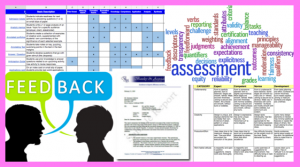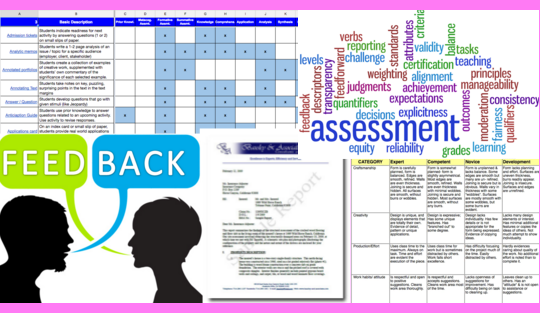


- Align Products with Outcomes
- Identify culminating products for a project that provide opportunities to apply skills and understandings from targeted standards
- Use multiple products and multiple checkpoints to provide formative feedback that students use to improve their understandings and products
- Use artifacts – evidence of student thinking – to assess targeted habits of mind and skills
- Unpack standards and use unpacked standards to write product rubrics
- Questions to answer with assessments
- How well do students know the content?
- What are students’ skill levels?
- How well do students apply knowledge while preparing products?
- Work backwards to make sure collection of assessments assesses all academic and character learning targets
- Plan out culminating products –
- these should involve transfer of knowledge and enduring understandings
- involve students in peer and self assessments of culminating products
- Plan out multiple products due at checkpoints so that students can get early and timely feedback
- examples: outlines, plans, blueprints, storyboards, report drafts, websites, final drafts, etc.
- Plan out artifacts that students will use to display their thinking as it evolves
- examples: notes, journal entries, emails, interviews, reflections, etc
- Know What to Assess
- Targeted standards, habits of mind, and 21st century skills can be further unpacked and rewritten as a set of academic and character learning targets.
- Learning targets can be long term (takes several days) and supporting (one day focus)
- Learning targets align with standards and other learning goals, they are specific and written in student friendly language.
- Learning targets can be used to convey learning goals to students.
- Use Rubrics
- Use rubrics to make project expectations explicit and transparent
- Use models to help convey meanings of rubric criteria. See this article: Models, critiques & descriptive feedback
- Analytic rubrics divide up criteria into several categories
- Holistic rubrics combine all rubric criteria into one score
- Design rubrics based on reflections and analyses of student work
- Focus criteria on central features of performance, not the features that are necessarily the easiest to see and count
- Use specific descriptive language to distinguish between criteria at different levels
- Use student friendly language that students can use to self-assess and peer-asses products
- When descriptive language fails to convey expectations clearly, use examples.
- 3 common features of rubrics: elements, scales and criteria.
- Elements are the names of the categories that group rubric criteria
- Scales are the words that describe levels of performance. Example: emerging, proficient, advanced
- Criteria – rubrics descriptors of specific expectations
- observable and/or measurable
- focus criteria on critical understandings and skills
- if possible use student work to develop criteria
- use Bloom’s Taxonomy to write criteria at different levels
- link scoring criteria to specific standards
- use student-friendly language
- maintain a high standard for exemplary work
- judge the product, not the process to create the product – avoid having to base grades on guesses

Standards-based project-based learning uses a collection of formative and summative assessments to check if students are learning knowledge and skills related to standards, habits of mind, and workplace competencies. Teachers need to design a balanced portfolio of assessments that will generate feedback for all targeted knowledge and skills. Students need timely feedback to clear up misconceptions, develop understandings and skills and improve products.

Preparation Steps
- Evaluate bundle of upcoming standards. Unpack standards and write set of academic long term and supporting learning targets.
- Determine which habits of mind and workplace competencies students need to successfully learn content and develop products and uses these selected skills to write character learning targets.
- Create a portfolio of assessments that can assess all academic and character learning targets.
- Create rubric that assesses key academic and character learning targets.
- Gather exemplars that go with rubric criteria
Early Implementation Steps
- Implement assessments throughout the product to assess and guide student understanding and skills as they develop throughout the project
- Set aside project checkpoints to meet with students in formal conferences to generate timely reflection and feedback on major works in progress. Set aside time for students to use feedback to improve products. For more details on what this could look like, see this article: Writing workshop
Advanced Implementation Steps
- Use analysis of student work to improve assessments (especially rubrics).
- Use Assessments Data base to discover and implement new assessment strategies other than traditional quizzes and tests

- PBL articles
- Assessments articles
- Writing workshop
- Learning targets
